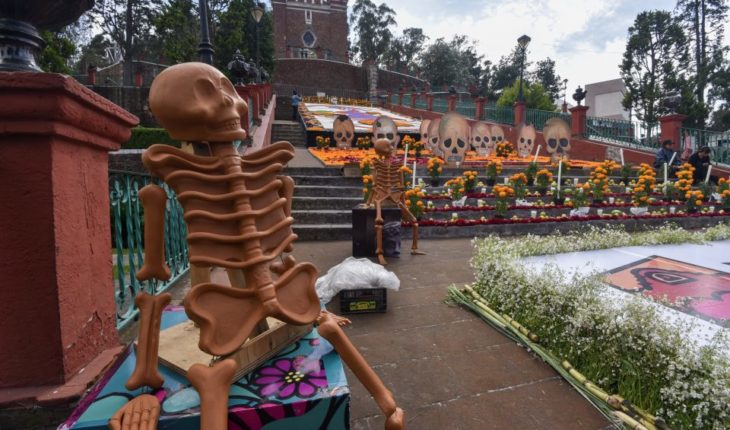Hundreds of people flock to the pantheons of the Toluca Valley, where they make the wake for the Day of the Dead, arrange their timbas with flowers and candles and some carry music for their dead. PHOTO: CRISANTA ESPINOSA AGUILAR /CUARTOSCURO.COM
Residents of Xochitlán Todos Santos, Puebla, watch all night in the municipal pantheon to accompany the graves of their deceased relatives on the traditional Day of the Dead. PHOTO: MIREYA NOVO/FOURTHCURO.CO
Migrants paint a graph on the border wall of people who have died in the attempt to cross the border since 1995 to date. During the last 24 years 8 thousand 339 migrants have died, according to data from the Migrant House in Tijuana PHOTO: OMAR MARTINEZ /CUARTOSCURO.COM
Female and transgender sex workers placed an offering on behalf of their murdered companions at Av. Tlalpan, in the CDMX: PHOTO: ANDREA MURCIA /CUARTOSCURO.COM
Day of the Dead Megaparasfile at the CDMX. PHOTO: LIZBETH PADILLA
Day of the Dead Megaparasfile at the CDMX. PHOTO: LIZBETH PADILLA.
Day of the Dead Megaparasfile in Mexico City PHOTO: MARIO JASSO/FOURTHCURO. Com
Fix the tombs, but above all visit the loved ones who are no longer there and clean the tombs, in a tradition in the Civil Pantheon of Dolores, which is located in the mayoralty of Miguel Hidalgo, in the CDMX PHOTO: VICTORIA VALTIERRA / CUARTOSCURO.COM
Going to the pantheon and taking out the remains of deceased relatives to clean them up is a tradition started from pre-Hispanic times in Pomuch, Campeche. PHOTO FOURTHCURO.
In Toluca, State of Mexico, the Catrineando parade takes place in the main streets of the city, catrinas, allegorical carts, botargas, bands of music, gave color to the celebration of the dead. PHOTO: CRISANTA ESPINOSA AGUILAR /CUARTOSCURO.COM
United Funeral homes of the Toluca Valley paraded through the city with some coffins and floats, and allusive costumes to date, as part of the Day of the Dead festivities. PHOTO: CRISANTA ESPINOSA AGUILAR /FOURTHCURO. With
Hundreds of people walked the streets of San Cristobal, Chiapas, in costumes of catrinas, catrines and creepy monsters to celebrate the festivities. The city has been characterized by the different cultures that converge on a day-to-day basis, this celebration is a clear example of how they mix and result in new traditions. PHOTO: ISABEL MATEOS /CUARTOSCURO.COM
Family members of the deceased came to clean, give maintenance, place the emblematic Flower of Celmpasuchil, eat and even sing as a family, this in the Panteon de Tezonco located south of Mexico City. PHOTO: ANDREA MURCIA /CUARTOSCURO.COM
Thousands of devotees to the Holy Death in the Morelos colony gathered to visit the altar dedicated to “La Niña Blanca”, brought incense, copal, marijuana, liquors and cigars PHOTO: PEDRO ANZA /CUARTOSCURO.COM
Masks, makeup, costumes, sweet skulls, flowers, abound in the markets of the City. Tomorrow is the day of the innocent Saints. PHOTO: VICTORIA VALTIERRA /CUARTOSCURO.COM
The sweet, chocolate and alove skulls are placed in the offerings PHOTO: VICTORIA VALTIERRA /CUARTOSCURO.COM
Like every year the town of Leona Vicario, in Quintana Roo celebrates the hanal pixan which takes place from 31 October to 2 November each year and coincides with the celebration of the Day of the Dead. Both traditions celebrate a reunion between living beings and their loved ones who have advanced on their journey to the afterlife. PHOTO: ELIZABETH RUIZ /CUARTOSCURO.COM
What we do in Animal Político requires professional journalists, teamwork, dialogue with readers and something very important: independence. You can help us keep going. Be part of the team.
Subscribe to Animal Politician, receive benefits and support free journalism.#YoSoyAnimal
translated from Spanish: A tour in images of how Mexico is celebrated on the Day of the Dead
November 2, 2019 |





